Pett Level to Winchelsea, via Pett Pools, the Royal Military Canal & the Pannel Valley 17.06.21
- Sim Elliott

- Jun 17, 2021
- 9 min read
Updated: Jul 7, 2021
I started this walk at Pett Level/Cliff End at 12.10 the end of the Fairlight Cliffs, just east of Hastings. (I got the train from Brighton to Hastings and then the 101 bus from Hastings to Pett Level). I started the walk by exploring the 6000 year-old submerged forest at Pett Level that is revealed at low tide. I then walked along the sea dyke to the Pett Pools, I then re-walked the dyke back to Pett Level, where I joined the Royal Military Canal path. Where the path from the Pannel Valley meets the Canal path, I walked up to the first hide (on the southern most scare) in the Panel Valley Nature Reserve. I then walked back to the Canal oath and walked to where it meets Winchelsea; I walked down the road to Winchelsea Beach and caught the 101, at 18.16, back to Hastings, to get the train back to Brighton. Details of the trains and buses can be found on the public transport page of my website.
My walk is represented by the orange line on this map (Goole Maps, Pett Level, Satellite View)
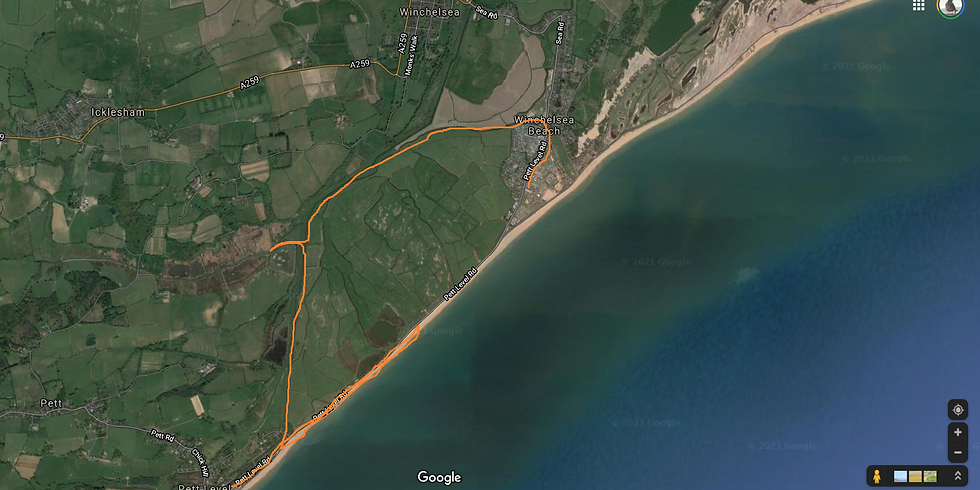
Pett Level
This is the beginning of the Royal Military Canal path at Pett Level/Cliff End, which formed the most part of my walk. See: Royal Military Canal - Romney Marsh, The Fifth Continent (theromneymarsh.net) for more details of the canal. The Royal Military Canal was a massive coastal defence work constructed between 1804 and 1809. Its purpose was to separate the expected landing and deployment of Napoleon's troops upon the coast of Romney Marsh and Walland Marsh from the interior of the country. The Government initially considered flooding the Marsh but favoured the canal, which was the idea of Lt. Col. Brown, the Assistant Quartermaster-General. ... The canal runs for 28 miles from Seabrook nr Hythe through Romney Marsh to Cliff End nr Hastings in East Sussex. After Hadrian's Wall and Offa's Dyke, it is the third-longest defensive structure in the UK. ... The Royal Military Canal canal has lots of wildlife, including the Marsh Frog, Emperor Dragonflies, Kingfishers and the majestic Mute Swan. The back drains and adjacent ditches of the canal provide an ideal habitat for the endangered water vole, which requires high water levels and thick bank side vegetation to survive. The main channel of the canal is more suited to the mink - a good swimmer and a voracious predator - which was introduced to this country in the 1930s. The high, tree covered banks of the defensive parapet have provided an ideal home for badgers. As night-time approaches they can be found snuffling around, looking for earthworms, grubs and bumblebee nests. The importance of the Royal Military Canal for wildlife has led to part being designated a Site of Special Scientific Interest (SSSI), with the remaining length designated a Local Wildlife Site. Royal Military Canal - Romney Marsh, The Fifth Continent (theromneymarsh.net)
There are some wonderful photographs of old Pett Level in one of the[posts of Cliff Dean's excellent blog: PETT LEVEL IN OLD PHOTOS | Birding Walks in RXland (wordpress.com)

Here is a woodpigeon at the start of the journey. Woodpigeons are considered as dull by many bird watchers because they are so common in the countryside; but they are beautiful birds despite their ubiquity,

When I arrived at Pett Level the village and beach were engulfed in a sea fret (a fog is caused by warm weather. When a pocket of warm air passes over the freezing sea, the moisture in the wait begins to condense. The air in the pocket then starts to cool down and forms a fog.
When this happens at the same time as a light wind, the fog is blown over the coast and, sometimes, more inland areas as well. What is sea fret and why does it spoil sunny days on the coast | The Scarborough News)

it was the perfect time to explore the submerged forest that is only visible at low tide.
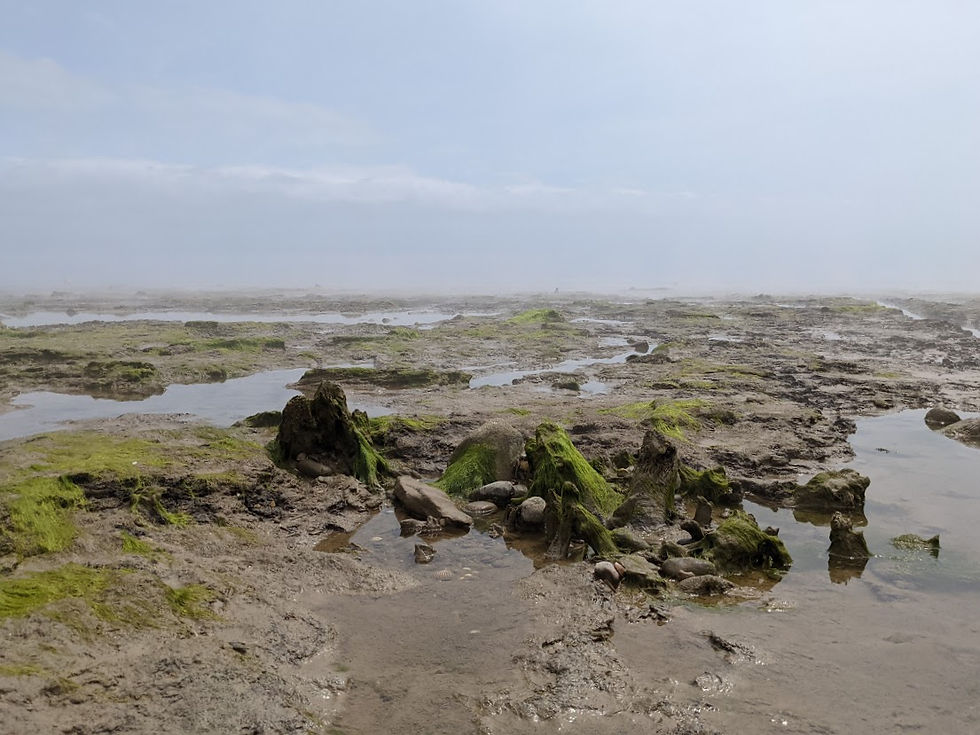
A sunken forest that can be seen in the sand at low tide on the Sussex coast is thought to be at least 6,000 years old - and a relic of a time when sea levels were about 100ft (30m) lower than today. Its spongy tree roots and branches emerge from beneath heaps of sand, rocks, barnacles and mussels when the tide goes out. Remains of the trees can be identified as oak, birch and hazel, saplings have been spotted standing in the sand, and walkers have gathered hazelnuts carbon-dated to 5,200 BC. The forest is thought to have been preserved after sea levels rose and flooded the woodland. According to Dr Barry Yates, from Rye Harbour Nature Reserve and Sussex Wildlife Trust, the forest is rarely studied, and most people who visit do not know what is under their feet. He said he had struggled to raise the profile of the local countryside but local people, who had been brought up with the landscape, tended to take it for granted. Walking over the expanse of roots and branches, he said: "People really come here for the rock pools. Everyone out here today - they probably don't know what they are walking on. "They probably haven't seen the trees." 'Little known' about ancient Pett Level sunken forest - BBC News

A Herring Gull









St Nicholas Church, Pett (on the beach). Formerly the "Rocket House"
In 1878 the Admiralty constructed a building on Pett Level beach for the local Coastguard. Its purpose was to house the Life Saving Rocket Apparatus used to help seafarers and fishermen in difficulties. Hence it became known as The Rocket House. Between the wars, the rocket launcher was moved elsewhere in Pett Level and so the Rocket House became surplus to requirements, so in 1935 the Diocese bought the Rocket House for £100 and on 26th April it was dedicated to St Nicholas by the Bishop of Lewes. In October it was authorised for Public Worship by the Bishop of Chichester. In the 80 years since then, services have been held continuously, save for the years 1940-1945, when the church was closed as part of the general evacuation of Pett Level and the militarisation of the beach.
In 1959 a porch was added made from Canadian cedar. Not much changed since then until 2015 was work started to repair the porch. From there internal refurbishment took place, replacing lights and cracked glass in the windows, cleaning chairs and paneling, sanding the floor. The vestry was also opened up to allow displays of old postcards, books to borrow or buy, and tea and coffee to be available to visitors. ... In March we hope to have a new cross on the front elevation of the porch, designed and made by another local artist, Leigh Dyer. St Nicholas Pett Level – Pett on the Net (pettnet.org.uk)
A


Photograph from Pet On The Net St Nicholas Pett Level – Pett on the Net (pettnet.org.uk)

Cliff End, the end of the Fairlight Cliffs

In 1852 the Pre-Raphaelite William Homan Hunt painted Our English Coasts, 1852 (‘Strayed Sheep’) - a representation of Covehurst bay, just west of Pett Level
In Modern Painters (1847) the writer and critic John Ruskin (1819-1900) exhorted young English artists to 'go to Nature in all singleness of heart, and walk with her laboriously and trustingly, having no other thoughts but how best to penetrate her meaning, and remember her instructions; rejecting nothing, selecting nothing, and scorning nothing; believing all things to be right and good, and rejoicing always in the truth.' Following Ruskin's dictum that art in its truthfulness can teach a moral lesson, William Holman Hunt created his greatest and most Pre-Raphaelite landscape.
The picture was first commissioned as a replica of the sheep in the background of The Hireling Shepherd (1851-2, City of Manchester Art Galleries), which was bought by the eminent naturalist W.J. Broderip. The copy was destined for Broderip's cousin, Charles T. Maud, but Hunt apparently persuaded him that an original picture would be more desirable.
The location for the picture was the Lover's seat, a well-known beauty spot perched on the cliffs overlooking Covehurst Bay, near Hastings. Hunt has paid scrupulous attention to natural detail, but the cliffs, sheep and parts of the foreground were all painted from different viewpoints, and the butterflies in the left foreground were painted indoors from a live specimen. Frances Fowle, December 2000 ‘Our English Coasts, 1852 (‘Strayed Sheep’)’, William Holman Hunt, 1852 | Tate
Ruskin's injunction to artists: "go to Nature in all singleness of heart, and walk with her laboriously and trustingly, having no other thoughts but how best to penetrate her meaning, and remember her instructions; rejecting nothing, selecting nothing, and scorning nothing; believing all things to be right and good, and rejoicing always in the truth." seems apt for the current age, with renewed popular interest in the environment provoked by environmental campaigning and renewed interest in the countryside when covid closed many places which people typically went to.
Toward Pett Pools



Pett Pools
Introduction: These Pools were dug in the 1940s to provide material for sea defences. They now provide stunning open water and marginal habitats for birds within the Pett Levels, and can be easily looked over from the adjacent road. Location: Adjacent to Pett Level Road, running between Winchelsea Beach and Fairlight, East Sussex. What can I do? The Pools are a perfect location for bird watching – you only need to get out of your car on the roadside to see a very wide range of wetland species. What can I see? Many different passage waders frequent the Pools - including sandpipers, dunlin, redshank and curlew. Several duck species can be seen – including shoveler, teal and wigeon. The fringing reedbeds attract bearded tit and, if you are lucky, you might see a marsh harrier quartering over the reeds. What can I hear? Listen out for the calls of some of the different waders, especially distinctive species such as curlew and redshank. Pett Pools (highweald.org)
A Mallard dabbling. Ducks can be split into two broad groups: dabblers and divers. As the name suggests, diving ducks feed mainly by diving underwater, using their strong feet (and sometimes their wings) to swim. Dabbling ducks, however, feed predominantly at the surface, sometimes even grazing on land. Many dabblers can often be seen upending, with their heads underwater and their bums in the air. How to identify dabbling ducks | The Wildlife Trusts

Oystercatchers flying over the pools

A male Tufted Duck

A flock of Mallards

Mute Swans and Cygnets


The sea fret - now over the hills behind Pett Levels

A Marsh Harrier hunts


The beach, separated from the Pools by the sea dyke,

There were many Common Terns foraging over the pools (for dragonflies ad other insects. The main prey of Common Terns are small fish up to 150 mm long; they frequently and sometimes predominantly feed on crustaceans or insects, occasionally on squid; they rarely take other invertebrates. Common Tern - Sterna hirundo - Birds of the World

A Cormorant



A Common Tern foraging for food

A Common Tern flying over the sea dye to the Channel

A Black-headed Gull flying over the sea dye to the Channel

Common Terns foraging for food


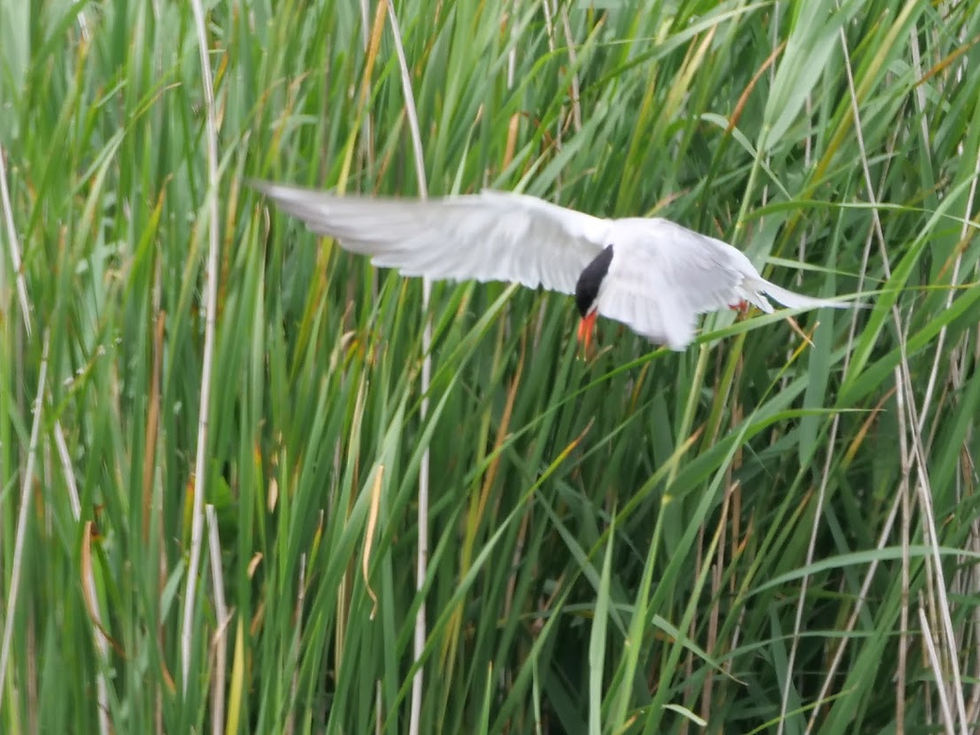







A Coot protecting its chick from an unthreatening Mallard (disappeared)
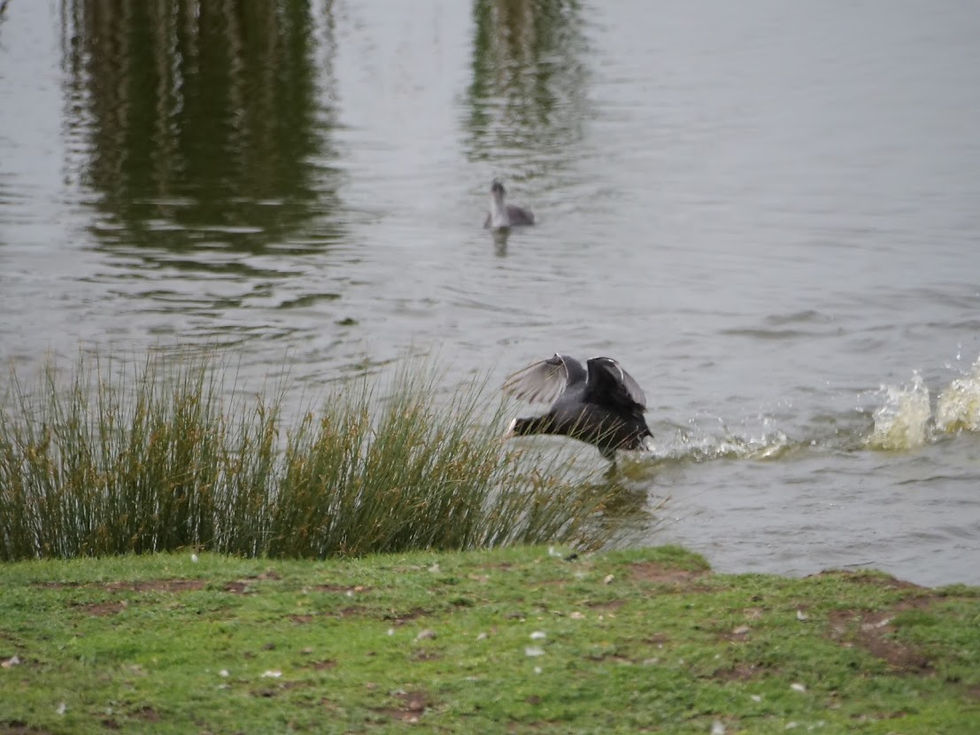
The same Coot and chich

More Common Terns






Walking back to Pett Level


The Royal Military Canal Path
Toot Rock is actually the rocky mound just at the beginning of the canal path.

Toot rock; a photograph from the Pett Level Preservation Trust

"If you look up toot in a modern dictionary you will probably find a definitiont[of "toot"] hat refers to a blast from a horn. However if you look at an earlier publication, I used “The Imperial Dictionary of the English language” published in 1883, several interesting and different definitions can be found. Toot; Saxon – totian – to project, Icelandic/Norse tota or tuta – a teat or teat like protuberance, these may give us an insight into the origins of the name. References to “Toot Hills” (natural or artificially created) can be found elsewhere, it seems they may have been used as lookout points. Toot Rock – Pett Level Preservation Trust
Along the path many Black-headed Gulls and Common Terns could be seen flying in and out of the southernmost scrape (a human-made poo) of the Pannel Valley Nature Reserve, where they nest. The fly our across the Pett Levels and the Pools and return with food for their young.

and I saw the probably the same Marsh Harrier again from the path



The canal proves a habitat for many wetland birds, including many warblers that perch on and forage from the reeds among the canal. I saw Mute Swans, Coots, Moorhens, Mallards and Sedge Warblers; and heard many Cetti's Warblers and Reed Warblers.


A Sedge Warbler






White Mutes Swans and White Sheep on the marshes of the Pett Levels are not always easy to differentiate at a distance.
The path to the Pannel Valley Nature Reserve (a left turn from the canal path when walking west to east toward Winchelsea)

Bottom of the path in Pannel Valley

The Royal Military Canal from the bridge at the beginning of the path through the Pannel Valley

Sheep on the hill to the right of the Pannel Valley path

An Oystercatcher flying; as usual I was alerted to hit by it's high-pitch piping call.


Pannel Valley Nature Reserve - from the hide in the Southernmost scrape.
Mallard ducklings.

Black-headed Gulls and their chicks on a human-made island in the human-made scrape


Black-headed Gulls, Common Terns and a Tufted Duck
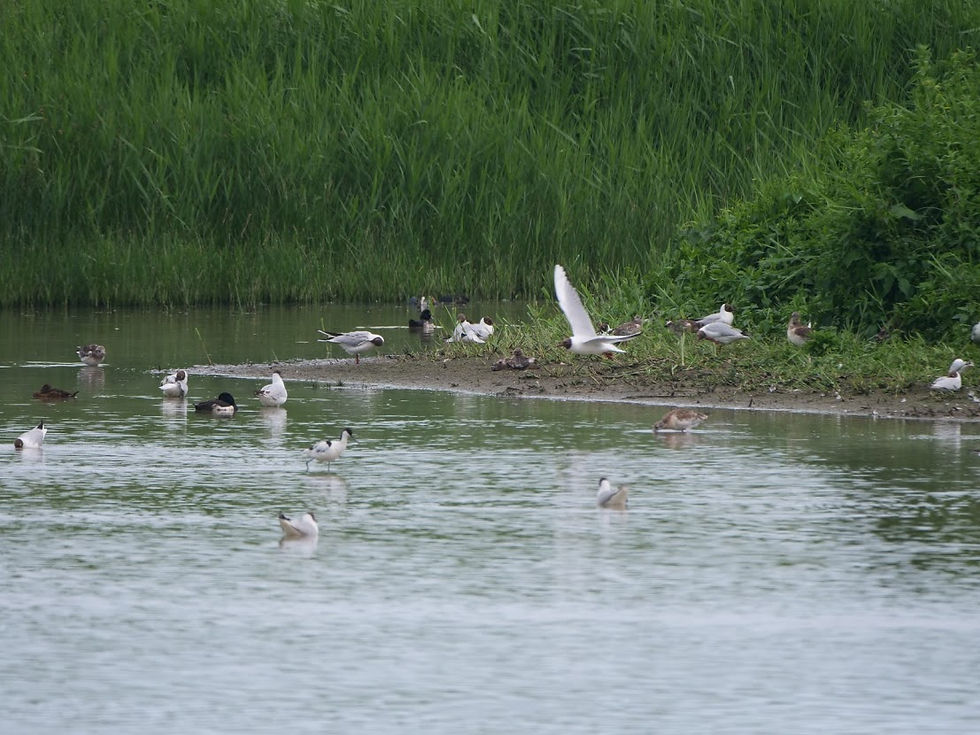
Black-headed Gulls, Common Terns, Mallards and a Ringed Plover

Black-headed Gulls,
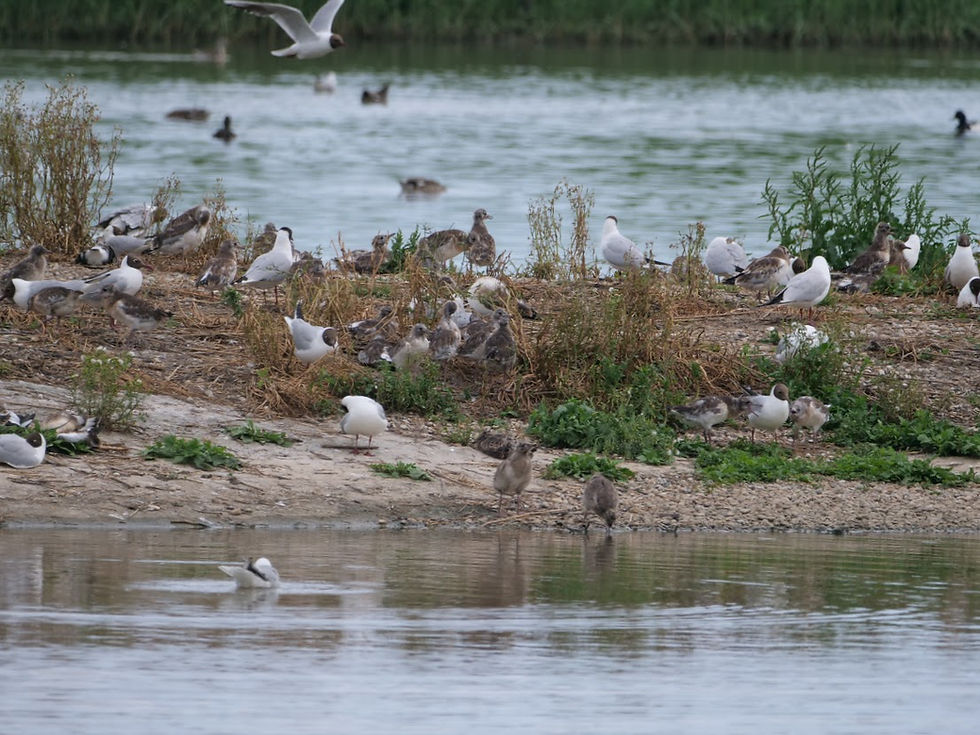
Black-headed Gulls, and a Shelduck

Black-headed Gulls

An Avocet bathing
Black-headed Gull chicks bathing
All of sudden a Sea Fret came over the marshes (Pett Levels) and up the Pannel Valley; spooking the birds





But the Sea Front went as quickly as it came

Leaving the door from the hide.

Back on the Royal Military Canal Path

which is also, the Saxon Shire Way

There were many dragonflies, damselflies and other insects along the canal. I think this is a damselfly

The canal, eastwards to Winchelsea
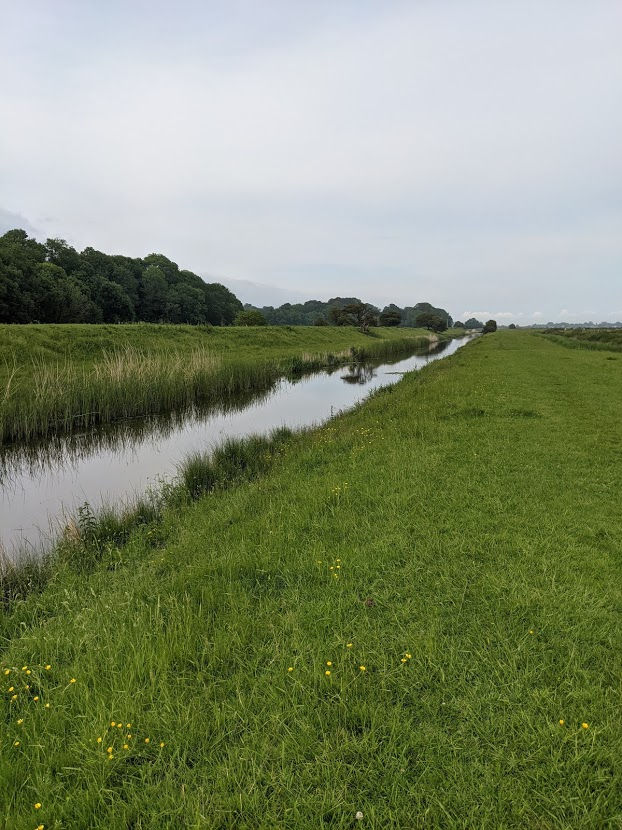
Mute Swans and cygnets


The marshes of Pett Levels are grazed by sheep and cattle; which are here overflown by a Grey Heron



And a saw a (probably the) Marsh Harrier again.


Further along the canal I noted two beautify Grey Herons one with an extraordinarily ,long neck

There were many Bumblebees (this one a buff-tailed bumblebee) foraging on white clover.


Flying off, when I walked by ... probable to the ...

The herony

just before the end of the Pett to Winchelsea section of the canal

As I walked down the road from the end of the canal to the bus stop at Winchelsea Beach I saw this beautiful Song Thrush; it looked huge

and saw some butterflies

Blackbirds and Rabits.




Comments